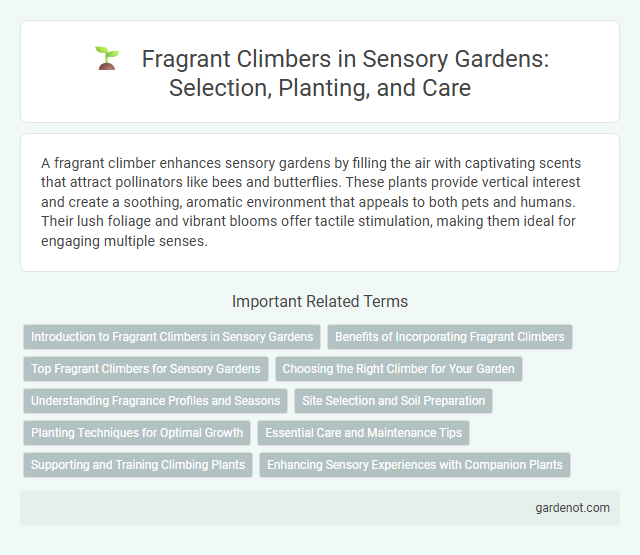A fragrant climber enhances sensory gardens by filling the air with captivating scents that attract pollinators like bees and butterflies. These plants provide vertical interest and create a soothing, aromatic environment that appeals to both pets and humans. Their lush foliage and vibrant blooms offer tactile stimulation, making them ideal for engaging multiple senses.
Introduction to Fragrant Climbers in Sensory Gardens
Fragrant climbers such as jasmine, honeysuckle, and clematis are essential elements in sensory gardens, offering captivating scents that enhance sensory stimulation. These plants provide vertical interest while releasing aromatic compounds that can evoke emotions and memories, promoting relaxation and well-being. Incorporating fragrant climbers supports biodiversity by attracting pollinators like bees and butterflies, enriching the garden's ecological balance.
Benefits of Incorporating Fragrant Climbers
Incorporating fragrant climbers into a sensory garden enhances aromatherapy benefits by releasing natural, soothing scents that improve mental well-being and reduce stress. These plants also attract pollinators such as bees and butterflies, increasing biodiversity and supporting local ecosystems. Their vertical growth maximizes garden space, providing both visual appeal and immersive sensory experiences.
Top Fragrant Climbers for Sensory Gardens
Top fragrant climbers for sensory gardens include jasmine, honeysuckle, and sweet pea, prized for their intense, sweet aromas that enhance sensory experiences. Jasmine's night-blooming varieties release a powerful scent that attracts pollinators, while honeysuckle provides a rich, honey-like fragrance ideal for tactile and olfactory engagement. Sweet pea adds vibrant colors and a delicate fragrance that stimulates both sight and smell, making these climbers essential choices for creating immersive sensory garden environments.
Choosing the Right Climber for Your Garden
Selecting the right fragrant climber involves considering factors such as climate adaptability, growth habit, and scent intensity to enhance your sensory garden experience. Popular choices include jasmine for its sweet, heady aroma and wisteria for its cascading blooms and rich fragrance. Ensure the climber thrives in your garden's soil type and receives adequate sunlight to maximize its olfactory impact.
Understanding Fragrance Profiles and Seasons
Fragrant climbers such as jasmine, honeysuckle, and climbing roses offer distinct fragrance profiles that change with the seasons, providing year-round sensory appeal. Jasmine thrives in summer with its sweet, exotic scent, while honeysuckle releases a honey-like aroma from late spring through fall. Understanding these seasonal variations helps in designing a sensory garden that maximizes aromatic experiences throughout the year.
Site Selection and Soil Preparation
Fragrant climbers thrive best in well-drained, fertile soil enriched with organic matter to ensure optimal growth and aroma release. Selecting a site with full to partial sunlight is crucial, as it enhances flowering and fragrance intensity. Proper soil preparation involves loosening the soil to a depth of at least 12 inches and incorporating compost or well-rotted manure to improve nutrient availability and moisture retention.
Planting Techniques for Optimal Growth
For optimal growth of fragrant climbers in a sensory garden, select well-draining soil enriched with organic matter to support healthy root development. Train the climber on sturdy trellises or arbors, ensuring even sunlight exposure to maximize fragrant flower production. Regular pruning promotes air circulation and encourages vigorous blooming, enhancing both scent and visual appeal.
Essential Care and Maintenance Tips
Fragrant climbers require well-drained soil enriched with organic matter and consistent watering to promote vigorous growth and abundant flowering. Prune regularly after blooming to maintain shape, encourage new shoots, and prevent overcrowding, which enhances air circulation and reduces disease risk. Apply balanced fertilizer in early spring and mulch around the base to conserve moisture and regulate soil temperature for optimal health.
Supporting and Training Climbing Plants
Supporting and training fragrant climbers in a sensory garden requires sturdy structures such as trellises, arbors, or pergolas to guide growth and maximize scent exposure. Regular pruning encourages healthy development and enhances the production of aromatic blooms. Selecting native or well-adapted species ensures robust growth and prolonged fragrance throughout the seasons.
Enhancing Sensory Experiences with Companion Plants
Fragrant climbers such as jasmine and honeysuckle enhance sensory gardens by releasing delightful aromas that attract pollinators and elevate the olfactory experience. Pairing these climbers with companion plants like lavender and mint intensifies fragrance layers and supports diverse sensory stimulation. These strategic plant combinations boost visual appeal, tactile variety, and scent complexity, creating a rich multi-sensory environment.
Fragrant climber Infographic

 gardenot.com
gardenot.com